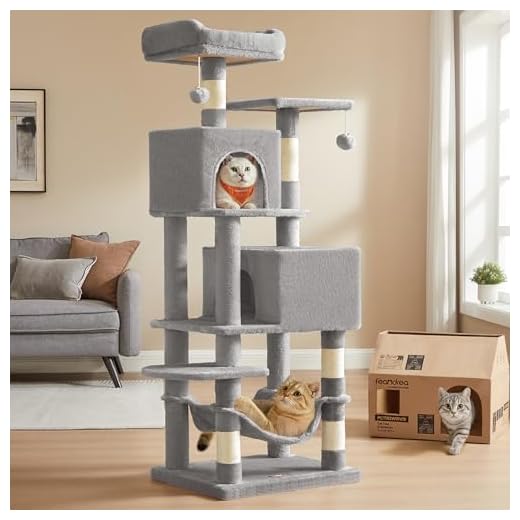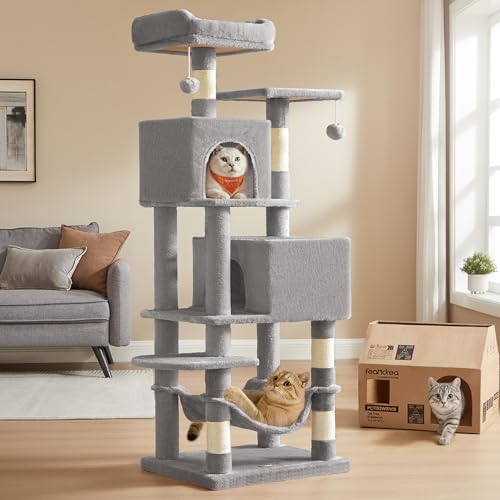



Start with gradual introductions. Keep the canine on a leash during initial meetings, allowing the feline to maintain control of the space. This simple step ensures that both animals feel secure and can observe each other without pressure.
Use positive reinforcement. Whenever the four-legged friend displays calm behavior around the other, reward them with treats or affection. This encourages a sense of safety and curiosity instead of fear or aggression.
Establish safe zones. Ensure the cat has high perches or secluded areas where they can retreat if they feel overwhelmed. The canine should be trained to respect these spaces, promoting a peaceful coexistence.
Gradually increase their interactions. Once they are comfortable in each other’s presence, allow for supervised playtime. Choose engaging toys that can be shared, reinforcing the idea that sharing space can be fun.
Monitor body language closely. Recognize signs of stress or discomfort in both animals. Adjust the interactions based on their reactions, ensuring that neither feels threatened. Consistent observance will foster trust over time.
Patience is key. Building a bond between these two species takes time. Celebrate small victories and remain committed to the process, knowing that a harmonious household is achievable.
Creating Positive Encounters
Introduce brief, positive interactions between the furry companions. Use a leash or a secure crate for the canine during initial introductions. Keep these meetings short, allowing both animals to observe each other without feeling threatened.
Gradual Desensitization
Gradually increase exposure time as comfort grows. Begin with the feline in a separate room, allowing the canine to sniff around the door. Reward calm behavior with treats or praise. This method builds a sense of security for both parties.
Establishing Boundaries
Ensure personal spaces are respected. Provide separate areas for relaxation and play. Use baby gates or barriers to create safe zones where neither feels cornered. This promotes a peaceful coexistence.
| Activity | Duration | Goal |
|---|---|---|
| Initial Introduction | 5-10 minutes | Familiarization |
| Sniffing Sessions | 2-5 minutes | Building Trust |
| Positive Reinforcement | Ongoing | Encouraging Calmness |
Continue to monitor interactions closely. Gradually decrease supervision as their relationship strengthens. Consistency is key for long-term harmony.
Understanding Dog and Cat Behavior
Recognizing the body language of both species is key. A wagging tail in my canine counterparts often suggests excitement, while a tense posture or growling can indicate discomfort or aggression. Conversely, when I flick my tail or flatten my ears, it’s a signal that I might feel threatened or annoyed. Owners should be observant of these cues to facilitate a better environment.
Socialization plays a significant role. Canines are generally pack animals, thriving on companionship, while we felines tend to be more solitary. Introducing a new friend should be gradual. Allowing each to explore the other’s scent through cloths can ease initial tension. This can create familiarity before any direct interactions occur.
Positive associations are effective. Rewarding my canine companion with treats when they exhibit calm behavior around me will reinforce their understanding that my presence is not a threat. This method aligns our experiences, fostering a sense of security and comfort.
Space is important. Providing separate areas for relaxation can minimize stress. Each of us should have a safe zone to retreat when feeling overwhelmed. This ensures that interactions remain positive and enjoyable.
Patience is key. Adjustments in behavior may take time. Continuous monitoring and adjusting strategies based on reactions will lead to a more harmonious relationship. Encouraging gentle play can also be beneficial, as it helps establish trust and mutual respect.
Using Positive Reinforcement Techniques
Reward-based approaches are key to shaping behavior in a friendly way. Here are specific methods to apply:
1. Treats and Rewards
- Choose high-value snacks that appeal to your friend.
- Give a treat immediately after a calm encounter with me.
- Gradually increase the time spent together before rewarding.
2. Praise and Affection
- Use a cheerful tone when your companion is calm around me.
- Offer pets or scratches as a reward for positive interactions.
- Be consistent in your praise to reinforce good behavior.
Timing is critical in these methods. Immediate rewards help your friend associate calmness with positive outcomes. Always maintain a relaxed atmosphere to build trust and comfort over time.
Gradually Increasing Exposure to Cats
Begin with short, controlled encounters. Place my feline self in a separate room while the canine companion remains nearby, allowing them to hear and smell each other without direct interaction. This initial step builds curiosity without overwhelming anyone.
After a few days, swap spaces. Allow the pup to explore my territory while I stay in a cozy corner. This helps both of us get accustomed to each other’s scents and presence. Keep these sessions brief, around 10-15 minutes, to maintain a relaxed atmosphere.
Once comfort levels rise, use a baby gate to create a visual barrier. Allow me to observe the furry friend while they remain contained. This way, there’s a safety buffer. Praise the pooch for calm behavior during these sights.
As familiarity increases, introduce supervised face-to-face meetings in a neutral space. Keep the leash on the pup, ensuring control. Use treats to reward calmness and positive interactions. If tensions flare, separate us immediately and try again later.
Gradually extend the duration of these meetings as both of us show signs of comfort. It’s crucial to recognize body language. If I puff up or the dog barks excessively, pause and revert to previous steps. Patience is key!
Finally, allow unrestrained interactions only when both of us demonstrate consistent calmness. Continue to reward good behavior, reinforcing the notion that time spent together is enjoyable.
Monitoring Interactions and Adjusting Approaches
Observing the dynamics between a furry friend and myself is key. It’s essential to pay attention to body language and vocalizations. I notice when my canine companion approaches me, tail wagging or ears perked up, signaling curiosity. If I see any signs of stress, like panting or growling, it’s time to step back and reassess the situation.
Creating a controlled environment helps. Designate a safe space for both of us. Gradually allow closer interactions under supervision. If I’m feeling comfortable, I might even approach, but if I retreat, it’s a cue for my human to take it slow.
Adjusting Techniques Based on Observations
Favoring rewarding moments is beneficial. If the pup behaves well around me, treats are a must! Positive experiences build trust. If the response is less than ideal, it might be wise to revisit previous steps, ensuring gradual exposure without overwhelming either of us.
Keeping a journal of these interactions can provide valuable insights. Documenting what went well and what didn’t helps in tailoring future encounters. Maintaining a consistent routine fosters familiarity, reducing anxiety on both sides.
Lastly, patience is paramount. Progress can be slow, and that’s perfectly acceptable. The goal is to cultivate a peaceful coexistence, and each small step counts.
Ensuring Ongoing Socialization and Training
Regular interactions are key. Set up a schedule for consistent meetups between the furry pals. Use short sessions to maintain their interest and reduce stress. If a particular encounter goes well, reward both with treats to reinforce positive experiences.
Rotate activities to keep things fresh. Introduce new toys, such as a remote control mouse for cats, to spark playful engagement. This not only stimulates curiosity but also encourages both to bond while having fun.
Keep observing their behavior. Adjust the environment if one feels uncomfortable. Create safe spaces where each can retreat. This prevents anxiety and promotes trust between the two.
Utilize training tools effectively. Incorporate basic commands and cues during interactions. This helps establish boundaries and clear communication, fostering a better understanding between them.
Document progress over time. Note any positive changes or setbacks in their relationship. This information is valuable for refining your approach, ensuring that both furry friends continue to thrive in their companionship.
Consider adding variety to their playtime. Use different spaces around the home or even the outdoors, ensuring safety first. A change of scenery can enhance their experiences together, making them more enjoyable.
Finally, don’t forget to include maintenance tasks. Keeping the environment clean, like using the best portable hot water pressure washer for outdoor areas, ensures a pleasant atmosphere for everyone. A tidy space contributes to a positive mood for both companions.








